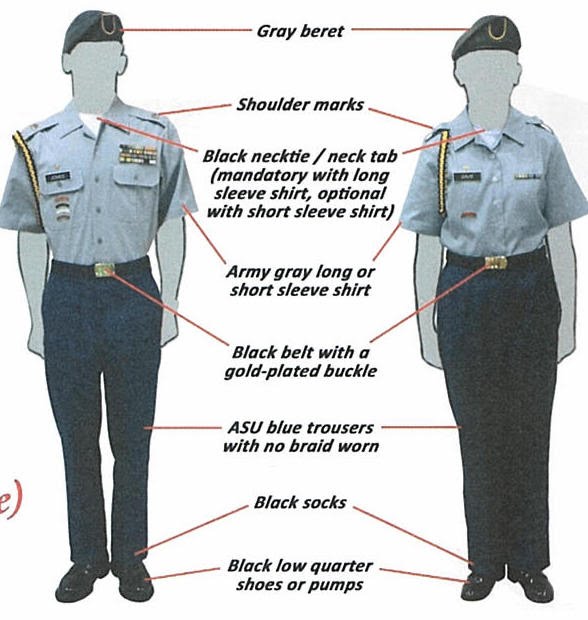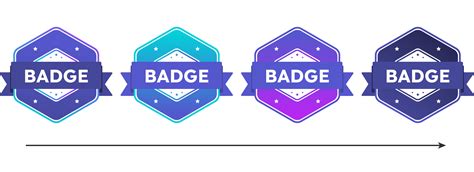15 Badges To Unlock: A Guide To Army Recognition

In the world of military enthusiasts and collectors, army recognition badges hold a significant place. These badges, often intricately designed and symbolic, serve as a testament to a soldier's skills, achievements, and experiences. This comprehensive guide aims to unravel the meaning and significance behind 15 distinct army recognition badges, shedding light on their unique stories and the criteria for earning them.
The Expert Infantryman’s Badge: A Symbol of Excellence

The Expert Infantryman’s Badge is one of the most prestigious and sought-after recognition badges in the infantry. To earn this badge, a soldier must demonstrate exceptional proficiency in various infantry skills. This includes marksmanship, land navigation, physical fitness, and knowledge of infantry tactics and techniques.
Criteria for Earning the Badge
The criteria for obtaining the Expert Infantryman’s Badge are rigorous and multifaceted. Soldiers must first complete a series of demanding tests, which evaluate their abilities in:
- Marksmanship: Precision shooting with various infantry weapons, including rifles and machine guns.
- Land Navigation: Accurate map reading and terrain navigation skills, often tested in challenging environments.
- Physical Fitness: Demonstrating superior physical endurance and strength through a series of physical challenges.
- Tactical Proficiency: Understanding and applying advanced infantry tactics, including squad and platoon-level operations.
Symbolism and Design
The design of the Expert Infantryman’s Badge is rich in symbolism. It features a rifle and bayonet crossed over a pair of wings, representing the infantry’s ability to move swiftly and engage in close combat. The badge is often made of high-quality materials, emphasizing the prestige associated with earning it.
| Criteria | Requirement |
|---|---|
| Marksmanship | Qualifying scores on rifle and machine gun firing tests. |
| Land Navigation | Successful completion of a challenging land navigation course. |
| Physical Fitness | Meeting or exceeding physical fitness standards set by the military. |
| Tactical Proficiency | Demonstrating knowledge of infantry tactics and successful completion of tactical exercises. |

The Combat Infantryman’s Badge: A Badge of Valor

The Combat Infantryman’s Badge is awarded to soldiers who have actively engaged in ground combat while assigned as infantry members. This badge is a testament to a soldier’s bravery, resilience, and dedication to their mission.
Eligibility and Criteria
To be eligible for the Combat Infantryman’s Badge, a soldier must have:
- Served in an infantry unit during a declared war or hostile action.
- Been directly involved in ground combat, including firefights, patrols, and assaults.
- Performed their duties with courage and distinction, often under enemy fire.
Design and Symbolism
The Combat Infantryman’s Badge features a rifle and bayonet, symbolizing the infantry’s role in close-quarters combat. The badge is often worn with pride, as it represents the ultimate test of a soldier’s mettle in the heat of battle.
| Eligibility Criteria | Requirement |
|---|---|
| Service in Infantry | Assignment to an infantry unit during a period of active combat. |
| Ground Combat | Participation in direct ground combat operations. |
| Courage and Distinction | Demonstrating exceptional bravery and skill in combat situations. |
The Parachutist Badge: A Badge of Aerial Prowess

The Parachutist Badge is awarded to soldiers who have successfully completed parachute training and qualified as parachutists. This badge is a testament to a soldier’s ability to operate in aerial environments and their proficiency in airborne operations.
Training and Qualification
Earning the Parachutist Badge involves a rigorous training process. Soldiers must undergo a series of challenging exercises, including:
- Ground training: Learning about parachute systems, equipment, and safety procedures.
- Jump school: Participating in multiple jumps from aircraft, often at varying altitudes and in different environments.
- Tactical training: Developing skills in airborne insertion, rapid deployment, and combat operations.
Badge Design and Symbolism
The Parachutist Badge features a stylized parachute with wings, symbolizing the soldier’s ability to descend from the skies. The badge is often worn with a sense of pride, as it represents the soldier’s mastery of a unique and demanding military skill.
| Training Criteria | Requirement |
|---|---|
| Ground Training | Successful completion of parachute equipment and safety training. |
| Jump School | Multiple qualifying jumps from aircraft, demonstrating proficiency in parachute deployment and landing. |
| Tactical Training | Training in airborne operations, including rapid deployment and combat techniques. |
The Special Forces Tab: A Badge of Elite Operations

The Special Forces Tab is a distinctive badge awarded to soldiers who have successfully completed the rigorous training and qualification process to become members of special forces units. This badge is a mark of exceptional skill, endurance, and the ability to operate in high-risk, complex environments.
Training and Qualification Process
Earning the Special Forces Tab is an arduous journey. Soldiers must undergo a series of intense training phases, including:
- Assessment and Selection: A demanding evaluation process to identify candidates with the necessary physical and mental attributes.
- Special Forces Qualification Course: An extensive training program covering a wide range of skills, including advanced weapons training, survival techniques, and specialized tactical operations.
- Language and Cultural Training: Developing proficiency in foreign languages and cultural awareness to operate effectively in diverse environments.
The Special Forces Tab: Symbolism and Design
The Special Forces Tab features a distinctive design, often incorporating the colors and symbols associated with special forces units. The tab is a symbol of elite status, representing the soldier’s ability to operate with precision and adaptability in the most challenging circumstances.
| Training Phases | Requirement |
|---|---|
| Assessment and Selection | Successful completion of a rigorous evaluation process, demonstrating physical and mental resilience. |
| Special Forces Qualification Course | Mastery of advanced military skills, including weapons handling, tactical operations, and survival techniques. |
| Language and Cultural Training | Proficiency in foreign languages and cultural understanding, essential for operating in diverse global environments. |
The Ranger Tab: A Badge of Infantry Excellence

The Ranger Tab is awarded to soldiers who have successfully completed the U.S. Army’s Ranger School, a highly demanding leadership and combat skills course. This badge is a symbol of infantry excellence and is highly regarded within the military.
Ranger School: A Test of Endurance
Ranger School is renowned for its intense and physically demanding curriculum. Soldiers undergo a series of rigorous training phases, including:
- Mountain Phase: Operating in mountainous terrain, including navigation, patrolling, and small unit tactics.
- Swamp Phase: Navigating and conducting combat operations in swampy environments, focusing on survival and evasion skills.
- Fort Benning Phase: The final phase, which tests soldiers' leadership and tactical skills in a variety of scenarios.
The Ranger Tab: Design and Symbolism
The Ranger Tab features a distinctive design, often incorporating the Ranger scroll and the words “Ranger School” in bold letters. The tab is a symbol of pride and honor, representing the soldier’s mastery of infantry tactics and their ability to lead under pressure.
| Training Phases | Requirement |
|---|---|
| Mountain Phase | Successful completion of mountain warfare training, including navigation and small unit tactics. |
| Swamp Phase | Proficiency in swamp warfare, including survival and evasion techniques. |
| Fort Benning Phase | Demonstrating leadership and tactical skills in various combat scenarios. |
The Military Freefall Parachutist Badge: A Badge of Aerial Precision
The Military Freefall Parachutist Badge is awarded to soldiers who have qualified as military freefall parachutists. This badge is a testament to a soldier’s ability to operate in high-altitude, high-risk environments and their proficiency in precision aerial insertion.
Training and Qualification
Earning the Military Freefall Parachutist Badge involves a specialized training process. Soldiers must undergo a series of rigorous exercises, including:
- Static Line Training: Learning to exit an aircraft and deploy a parachute at a specific altitude.
- Military Freefall Training: Developing skills in high-altitude, high-opening parachute jumps, often involving specialized equipment and techniques.
- Tactical Training: Training in precision aerial insertion, including the ability to land in confined spaces and operate in urban environments.
Badge Design and Symbolism
The Military Freefall Parachutist Badge features a stylized parachute with wings, often incorporating the colors and symbols associated with special operations units. The badge is a symbol of precision and adaptability, representing the soldier’s ability to operate in the most challenging aerial environments.
| Training Criteria | Requirement |
|---|---|
| Static Line Training | Successful completion of static line parachute training, demonstrating proficiency in basic parachute deployment. |
| Military Freefall Training | Mastery of high-altitude, high-opening parachute jumps, including specialized equipment and techniques. |
| Tactical Training | Training in precision aerial insertion, including urban operations and confined space landings. |
The Special Operations Diver Badge: A Badge of Aquatic Excellence

The Special Operations Diver Badge is awarded to soldiers who have qualified as special operations divers. This badge is a testament to a soldier’s ability to operate in aquatic environments and their proficiency in underwater combat and reconnaissance operations.
Training and Qualification
Earning the Special Operations Diver Badge involves a specialized and demanding training process. Soldiers must undergo a series of rigorous exercises, including:
- Scuba Diving Training: Learning to dive with scuba equipment, including navigation, buoyancy control, and underwater communication.
- Combat Diving Training: Developing skills in underwater combat, including weapon handling, tactical operations, and special reconnaissance techniques.
- Tactical Swimming Training: Training in tactical swimming, including stealthy movement, evasion, and escape techniques.
Badge Design and Symbolism
The Special Operations Diver Badge features a stylized diver with a spear, often incorporating the colors and symbols associated with special operations units. The badge is a symbol of aquatic excellence, representing the soldier’s ability to operate with precision and stealth in the underwater domain.
| Training Criteria | Requirement |
|---|---|
| Scuba Diving Training | Successful completion of scuba diving training, including navigation and underwater communication. |
| Combat Diving Training | Mastery of underwater combat and special reconnaissance techniques. |
| Tactical Swimming Training | Proficiency in tactical swimming, including stealthy movement and evasion techniques. |
The Air Assault Badge: A Badge of Aerial Mobility

The Air Assault Badge is awarded to soldiers who have qualified as air assault crew members. This badge is a testament to a soldier’s ability to operate in aerial mobility operations and their proficiency in air-to-ground coordination.
Training and Qualification
Earning the Air Assault Badge involves a specialized training process. Soldiers must undergo a series of rigorous exercises, including:
- Air Assault Operations Training: Learning to operate in air assault missions, including air-to-ground coordination, rapid deployment, and tactical air operations.
- Rappelling and Fast Roping Training: Developing skills in rappelling and fast roping, which are essential for rapid deployment from aircraft.
- Tactical Air Operations Training: Training in the use of helicopters and other aircraft for tactical operations, including assault and resupply missions.
Badge Design and Symbolism
The Air Assault Badge features a stylized helicopter with wings, often incorporating the colors and symbols associated with air assault units. The badge is a symbol of aerial mobility, representing the soldier’s ability to operate with speed and agility in the air.
| Training Criteria | Requirement |
|---|---|
| Air Assault Operations Training | Successful completion of air assault training, including air-to-ground coordination and tactical air operations. |
| Rappelling and Fast Roping Training | Proficiency in rappelling and fast roping techniques, essential for rapid deployment. |
| Tactical Air Operations Training | Training in the use of helicopters and aircraft for tactical operations, including assault and resupply missions. |
The Drill Sergeant Identification Badge: A Badge of Leadership

The Drill Sergeant Identification Badge is awarded to soldiers who have successfully completed the U.S. Army’s Drill Sergeant School and have served as drill sergeants. This badge is a symbol of leadership, mentorship, and the ability to train and shape the next generation of soldiers.
Drill Sergeant School: A Test of Teaching Excellence
Drill Sergeant School is a demanding program designed to develop soldiers into effective leaders and mentors. The curriculum focuses on:
- Leadership and Mentorship: Developing skills in leadership, communication



